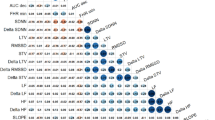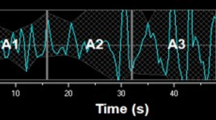Abstract
Linear and nonlinear fetal heart rate (FHR) indices, namely mean FHR, interval index (II), very low, low and high frequencies, approximate (ApEn) and sample entropy (SampEn), were computed, immediately before delivery, in the initial and final FHR tracing segments, from 48 normal, 10 mildly acidemic and 10 moderate-to-severely acidemic fetuses. Progression of labor was associated with a significant increase in linear frequency domain indices whereas nonlinear indices were significantly decreased. Moderate-to-severe fetal acidemia was associated with a significant decrease in nonlinear indices. The best discrimination between moderate-to-severe acidemic fetuses and the remaining cases was obtained combining II and ApEn(2,0.15), with a specificity of 71% and a sensitivity of 80%. These findings support the hypothesis of increased autonomic nervous system activity in the final minutes of labor and of decreased central nervous system activity, both in the final minutes of labor and in moderate-to-severe acidemic fetuses.



Similar content being viewed by others
References
ACOG (1995) ACOG technical bulletin. fetal heart rate patterns: monitoring, interpretation, and management. Int J Gynecol Obstet 51:65–74
Ayres-de-Campos D, Bernardes J, Costa-Pereira A, Pereira-Leite L (1999) Inconsistencies in expert’s classification of cardiotocograms and subsequent clinical decision. Br J Obstet Gynecol 106:1307–1310
Ayres-de-Campos D, Bernardes J, Garrido A, de Sá JM, Pereira-Leite L (2000) Sisporto 2.0: a program for automated analysis of cardiotocograms. J Mat Fet Med 9:311–318
Bernardes J, de Campos DA, Costa-Pereira A, Pereira-Leite L, Garrido A (1998) Objective computerized fetal heart rate analysis. Int J Gynecol Obstet 62:141–147
Bernardes J, Costa-Pereira A, de Campos DA, van Geijn HP, Pereira-Leite L (1997) Evaluation of interobserver agreement of cardiotocograms. Int J Gynecol Obstet 57(1):33–37
Bernardes J, Moura C, de Sá JPM, Pereira-Leite L (1991) The porto system for automated cardiotocographic signal analysis. J Perinat Med 19:61–65
Boog G (2004) Analyse informatisTe du rythme cardiaque foetal au cours de la grossesse et de l’accouchement. EncyclopTdie MTdico-Chirurgicale 148(5-049-D-23), pp 1–10
Carter MC (1993) Signal processing and display—cardiotocographs. Br J Obstet Gynaecol 100(9):21–23
Chaffin DG, Barnard JM, Phernetton T, Reed KL (1998) Decreased approximate entropy of heart rate variability in the hypoxic ovine fetus. J Matern Fetal Invest 8:23–26
Chung DY, Sim YB, Park KT, Yi SH, Shin JC, Kim SP (2001) Spectral analysis of fetal heart rate variability as a predictor of intrapartum fetal distress. Int J Gynecol Obstet 73:109–116
Colenbrander GJ, van Geijn HP, Goovaerts HG (1994) Acquisition of fetal heart rate signals. In: Geijn HPV, Copray FJA (eds) A critical appraisal of fetal surveillance. Elsevier Science, Amsterdam, pp 203–210
Dawes GS, Moulden M, Sheil O, Redman CWG (1992) Approximate entropy, a statistic of regularity, applied to fetal heart rate data before and during labour. Obstet Gynecol 80(5):763–768
Dudewicz E, Mishra S (1988) Modern mathematical statistics. Wiley, New York
Echeverrfa JC, Hayes-Gill BR, Crowe JA, Woolfson MS, Croaker GDH (1990) Detrended fluctuation analysis: a suitable method for studying fetal heart rate variability? Int J Biomed Comput 25:287–294
Felgueiras C, de Sá JPM, Bernardes J, Gama S (1998) Fractal characterisation of fetal heart rate sequences. Biomed Eng 36(2):197–201
Fusheng Y, Bo H, Qingyu T (1998) Approximate entropy and its application in biosignal analysis. In: Akay M (ed) Nonlinear biomedical signal processing. Dynamical analysis and modelling, vol II. IEEE Press, New York, pp 72–91
Gonçalves H, Rocha AP, de Campos DA, Bernardes J (2006) Internal versus external intrapartum foetal heart rate monitoring: the effect on linear and nonlinear parameters. Physiol Meas 27:307–319
Gough NA (1993) Fractal analysis of foetal heart rate variability. Physiol Meas 14(3):309–315
Hayes M (1996) Statistical digital signal processing and modelling. Wiley, New York
Hewlett-Packard (1993) Hewlett-Packard Series 50 Service Manual, M1351A and 1353A. Germany
King T, Parer J (2000) The physiology of fetal heart rate patterns and perinatal asphyxia. J Perinat Neonat Nurs 14(3):19–39
Li X, Tang D, Zhou S, Zhou G, Wang C, Zhuang Y, Wu G, Shen L (2004) Redistribution of power spectrum of heart rate variability during acute umbilical artery embolism and hypoxemia in late-gestation fetal sheep. Eur J Obstet Gynecol Reprod Biol 114:137–143
Magenes G, Signorini MG, Arduini D (2000) Classification of cardiotocographic records by neural networks. In: IJCNN 2000, Proceedings of the IEEE-INNS-ENNS international joint conference on neural networks, vol 3, pp 637–641
Martin JCB (1998) Electronic fetal monitoring: a brief summary of its development, problems and prospects. Eur J Obstet Gynecol Reprod Biol 78:133–140
Martinez WL, Martinez AR (2002) Computational statistics handbook with MATLAB. CRC Press, Boca Raton
Oppenheimer LW, Lewinsky RM (1994) Power spectral analysis of fetal heart rate. Baillieres Clin Obstet Gynaecol 8(3):643–661
Pincus S (1991) Approximate entropy as a measure of system complexity. Proc Natl Acad Sci USA 88:2297–2301
Pincus S (1995) Approximate entropy (apen) as a complexity measure. Chaos 5(1):110–117
Pincus S, Viscarello R (1992) Approximate entropy: a regularity measure for fetal heart rate analysis. Obstet Gynecol 79(2):249–255
di Renzo GC, Montani M, Fioriti V, Clerici G, Branconi F, Pardini A, Indraccolo R, Cosmi EV (1996) Fractal analysis: a new method for evaluating fetal heart rate variability. J Perinat Med 24(3):261–269
Richman JS, Moorman JR (2000) Physiological time-series analysis using approximate entropy and sample entropy. Am J Physiol Heart Circ Physiol 278:H2039–H2049
Ripley BD (1996) Pattern recognition and neural networks. Cambridge University Press, London
Rooth G, Huch A, Huch R (1987) FIGO news. guidelines for the use of fetal monitoring. Int J Gynecol Obstet 25:159
Royal College of Obstetricians and Gynaecologists (2001) Evidence-Based Clinical Guideline Number 8. The use of electronic fetal monitoring. Royal College of Obstetricians and Gynaecologists, London
Salamalekis E, Thomopoulos P, Giannaris D, Salloum I, Vasios G, Prentza A, Koutsouris D (2002) Computerised intrapartum diagnosis of fetal hypoxia based on fetal heart rate monitoring and fetal pulse oximetry recordings utilising wavelet analysis and neural networks. BJOG 109(10):1137–1142
Signorini MG, Cerutti S (1999) Nonlinear properties of cardiovascular time series. In: Di Rienzo M, Mancia G, Parati G, Pedotti A, Zanchetti A (eds) Methodology and clinical applications of blood pressure and heart rate analysis, IOS Press, Amsterdam, pp 73–89
Signorini MG, Magenes G, Cerrutti S, Arduini D (2003) Linear and nonlinear parameters for the analysis of fetal heart rate signal from cardiotacographic recordings. IEEE Trans Biomed Eng 50(3):365–373
Siira SM, Ojala TH, Vahlberg TJ, Jalonen JO, Valimaki IA, Rosen KG, Ekholm EM (2005) Marked fetal acidosis and specific changes in power spectrum analysis of fetal heart rate variability recorded during the last hour of labour. Br J Obstet Gynaecol 112:418–423
Suzuki T, Okamura K, Kimura Y, Watanabe T, Murotsuki NYJ, Uehara S, Yajima A (2000) Power spectral analysis of R-R interval variability before and during the sinusoidal heart rate pattern in fetal lambs. Am J Obstet Gynecol 182:1227–1232
Task-Force (1996) Heart rate variability. standards of measurement, physiological interpretation, and clinical use. task force of the european society of cardiology and the north american society of pacing and electrophysiology. Eur Heart J 17:354–381
Teich MC, Lowen SB, Jost BM, Vibe-Rheymer K, Heneghan C (1998) Heart rate variability: measures and models. In: Akay M (ed) Nonlinear biomedical signal processing. Dynamic analysis and modeling, vol II. IEEE Press, New York, pp. 159–213
Yum MK, Kim K, Kim JH, Park EY (2004) A consistent abnormality in the average local smoothness of fetal heart rate in growth-restricted fetuses affected by severe pre-eclampsia. Hypertens Res 27(12):911–918
Acknowledgment
The authors acknowledge project POSI/CPS/40153 /2001 funded by FCT (Fundação para a Ciência e Tecnologia, Portugal).
Author information
Authors and Affiliations
Corresponding author
Rights and permissions
About this article
Cite this article
Gonçalves, H., Rocha, A.P., Ayres-de-Campos, D. et al. Linear and nonlinear fetal heart rate analysis of normal and acidemic fetuses in the minutes preceding delivery. Med Bio Eng Comput 44, 847–855 (2006). https://doi.org/10.1007/s11517-006-0105-6
Received:
Accepted:
Published:
Issue Date:
DOI: https://doi.org/10.1007/s11517-006-0105-6




